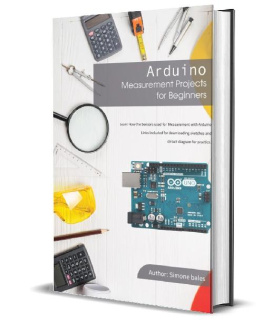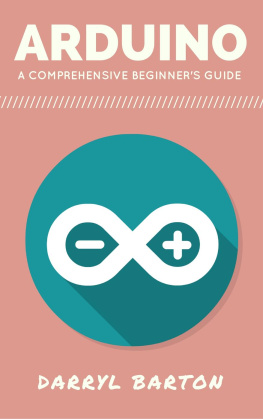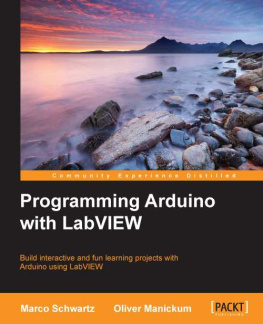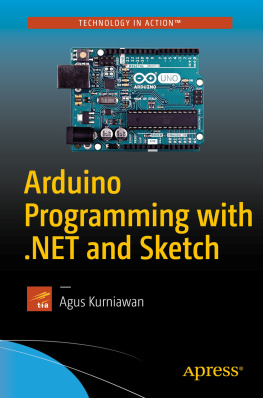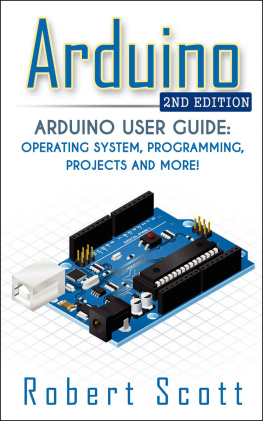Simone bales - Arduino Measurement Projects for Beginners: Arduino Programming basics and Get started guide
Here you can read online Simone bales - Arduino Measurement Projects for Beginners: Arduino Programming basics and Get started guide full text of the book (entire story) in english for free. Download pdf and epub, get meaning, cover and reviews about this ebook. year: 2018, genre: Computer. Description of the work, (preface) as well as reviews are available. Best literature library LitArk.com created for fans of good reading and offers a wide selection of genres:
Romance novel
Science fiction
Adventure
Detective
Science
History
Home and family
Prose
Art
Politics
Computer
Non-fiction
Religion
Business
Children
Humor
Choose a favorite category and find really read worthwhile books. Enjoy immersion in the world of imagination, feel the emotions of the characters or learn something new for yourself, make an fascinating discovery.
- Book:Arduino Measurement Projects for Beginners: Arduino Programming basics and Get started guide
- Author:
- Genre:
- Year:2018
- Rating:5 / 5
- Favourites:Add to favourites
- Your mark:
- 100
- 1
- 2
- 3
- 4
- 5
Arduino Measurement Projects for Beginners: Arduino Programming basics and Get started guide: summary, description and annotation
We offer to read an annotation, description, summary or preface (depends on what the author of the book "Arduino Measurement Projects for Beginners: Arduino Programming basics and Get started guide" wrote himself). If you haven't found the necessary information about the book — write in the comments, we will try to find it.
Simone bales: author's other books
Who wrote Arduino Measurement Projects for Beginners: Arduino Programming basics and Get started guide? Find out the surname, the name of the author of the book and a list of all author's works by series.
Arduino Measurement Projects for Beginners: Arduino Programming basics and Get started guide — read online for free the complete book (whole text) full work
Below is the text of the book, divided by pages. System saving the place of the last page read, allows you to conveniently read the book "Arduino Measurement Projects for Beginners: Arduino Programming basics and Get started guide" online for free, without having to search again every time where you left off. Put a bookmark, and you can go to the page where you finished reading at any time.
Font size:
Interval:
Bookmark:
Contents
Copyright 2020 by STEMedu - All rights reserved.
This document is geared towards providing exact and reliable information in regards to the topic and issue covered. The publication is sold with the idea that the publisher is not required to render an accounting, officially permitted, or otherwise, qualified services. If advice is necessary, legal or professional, a practiced individual in the profession should be ordered.
- From a Declaration of Principles which was accepted and approved equally by a Committee of the American Bar Association and a Committee of Publishers and Associations.
In no way is it legal to reproduce, duplicate, or transmit any part of this document in either electronic means or in printed format. Recording of this publication is strictly prohibited, and any storage of this document is not allowed unless with written permission from the publisher. All rights reserved.
The information provided herein is stated to be truthful and consistent, in that any liability, in terms of inattention or otherwise, by any usage or abuse of any policies, processes, or directions contained w
ithin is the sole and utter responsibility of the recipient reader. Under no circumstances will any legal responsibility or blame be held against the publisher for any reparation, damages, or monetary loss due to the information herein, either directly or indirectly.
Respective authors own all copyrights not held by the publisher.
The information herein is offered for informational purposes solely and is universal as so. The presentation of the information is without a contract or any type of guarantee assurance.
The trademarks that are used are without any consent, and the publication of the trademark is without permission or backing by the trademark owner. All trademarks and brands within this book are for clarifying purposes only and are owned by the owners themselves, not affiliated with this document.
Basics of Electronics
Electronics Primer
Before jumping into the Arduino Completely, we present the foundations of electricity and electronics and introduce critical concepts used. Here provides a broad overview of electronics to readers who have little to no experience with electronics and electricity. If youre already comfortable with some of the topics in this chapter, you can skip these and go to the programming page.
If youre new to electronics or just want a refresher, we suggest reading this webpage in full. While its not a complete guide to electronics (there are whole books, classes, and degrees on the subject), this chapter is a handy reference designed to arm you with basic concepts and vocabulary.
What Is Electricity?
To understand electricity, you first need to understand the structure of an atom. Atoms are the building blocks of everything around you. An atom is made up of protons, neutrons, and electrons. The electrons have a negative charge, and the protons have a positive charge. A typical atom has the same number of electrons as protons and therefore is neutral in charge. Electricity is a form of energy that involves the movement or storage of charges; it is the phenomenon that occurs when we push or force charges to move in a prescribed manner or a defined path.
In simple terms, electricity is a form of energy that we can harness and convert into heat, light, movement, and power. Electricity has three main properties that will be important to us as we build projects: current, voltage, and power.
Current
The flow of electrical energy through a circuit is called the current. Electrical current flows through a circuit from the positive side of a power source, such as a battery, to the negative side of the power source. This is known as direct current (DC).In some circuits; the negative side is called ground (GND). Current is measured in amperes or amps (A). Small amounts of current are measured in milliamps (mA), where 1,000 milliamps equal 1 amp.
Voltage
Voltage is a measure of the difference in potential energy between a circuits positive and negative ends. This is measured in volts (V). The higher the voltage, the faster the current moves through a circuit.
Power
Power is a measurement of the rate at which an electrical device converts energy from one form to another. Power is measured in watts (W). For example, a 100 W light bulb is much brighter than a 60 W bulb because the higher-wattage bulb converts more electrical energy into light. A simple mathematical relationship exists among voltage, current, and power:
Power (W) = Voltage (V) Current (A)
What Is a Circuit?
Even with the electrical forces pushing them, charges need a path to follow from a point of higher potential to the point of lower potential. The path by which charges move from the positive (+) side of a battery (high potential) to the negative () side of the battery (low potential) is called a circuit. A circuit consists of a closed path from the positive terminal to the negative terminal through a device such as a light-emitting diode (LED), resistor, light, or motor.
In order for charges to move, the path must be made out of a material that is conductive. Conductivity is not an absolute measure but more of a continuum. In other words, some materials allow charges to move more freely than others.
Ohms Law
As you may already have guessed, there is a relationship between current, voltage, and resistance. This relationship is commonly called Ohms Law, and it is represented mathematically as follows:
V = I R
In this equation, V represents the voltage; I represent the current, and R is the resistance.
Schematics

Schematics are simplified drawings of circuits. We sometimes also call these wiring diagrams or circuit blueprints. A schematic shows what is connected to what and which components to use in building the circuit.
Analog VS Digital
With the concepts of circuits, components, voltage, current, and resistance defined, we can now talk about two different approaches to electronics: analog and digital. These approaches are not mutually exclusive, and you cant really understand the circuits you build without understanding both concepts.

Analog deals with values that vary within a set range. Think of the dimmer switch in some dining rooms; that is analog. Analog values can be on, off, and anything in between. Digital values, on the other hand, have only two. States: on or off.
Digital electronics tend to include a microcontroller or microprocessor that is programmed to turn things on and off in response to conditions, whereas analog circuits tend to use components to vary the current, voltage, and resistance of a circuit to achieve the same result. There are advantages and disadvantages to both ways of thinking, but you cant solely use one and not the other. For example, you couldnt read the temperature using a microcontroller without using a number of analog components as well.
What is Microcontroller?
A microcontroller is a small computer that you can program by uploading a program or set of instructions. Microcontrollers are used to automate simple tasks, like controlling the temperature of your house or watering your lawn when its dry.
LED
An LED is an acronym for Light Emitting Diode; it is a type of diode that illuminates when electricity passes through it. Their voltage drop is higher than a standard diode, from1.2v for an infrared LED, up to 3.5v for blue and ultraviolet LED. These LEDs comes in different size and different colors. If you take a closer look to that LED picture, one lead (leg) of the LEDs shorter and another one is longer. The shorter one is known as a cathode (negative (-) symbol), and the longer one is known as an anode (positive (+) symbol). If the current passing through the LED is too high, you will lose LED. A LED can withstand up to 3.5v, the output voltage from the Arduino pins are 5V to step down this voltage, a resistor in series with LED should use to prevent the LED from hurt.
Next pageFont size:
Interval:
Bookmark:
Similar books «Arduino Measurement Projects for Beginners: Arduino Programming basics and Get started guide»
Look at similar books to Arduino Measurement Projects for Beginners: Arduino Programming basics and Get started guide. We have selected literature similar in name and meaning in the hope of providing readers with more options to find new, interesting, not yet read works.
Discussion, reviews of the book Arduino Measurement Projects for Beginners: Arduino Programming basics and Get started guide and just readers' own opinions. Leave your comments, write what you think about the work, its meaning or the main characters. Specify what exactly you liked and what you didn't like, and why you think so.

